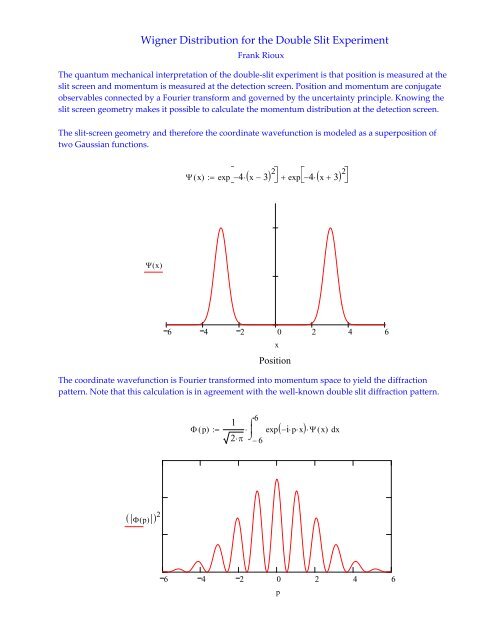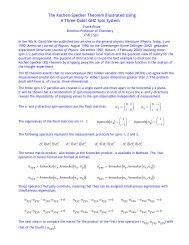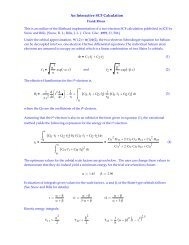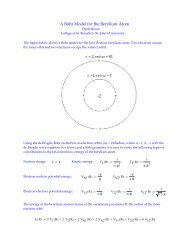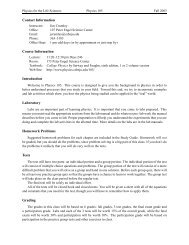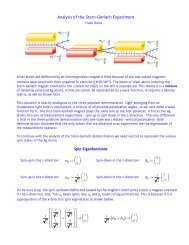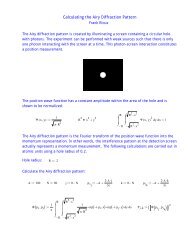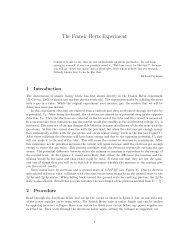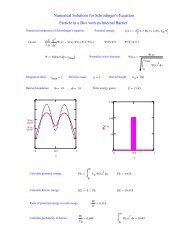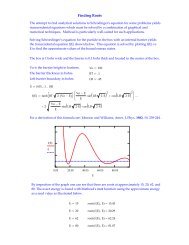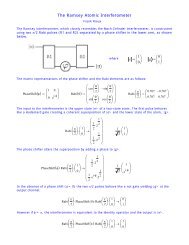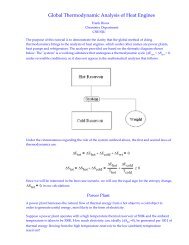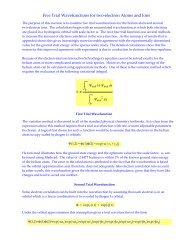Mathcad - Wigner-2-Slit - Users.csbsju.edu
Mathcad - Wigner-2-Slit - Users.csbsju.edu
Mathcad - Wigner-2-Slit - Users.csbsju.edu
- No tags were found...
Create successful ePaper yourself
Turn your PDF publications into a flip-book with our unique Google optimized e-Paper software.
<strong>Wigner</strong> Distribution for the Double <strong>Slit</strong> ExperimentFrank RiouxThe quantum mechanical interpretation of the double‐slit experiment is that position is measured at theslit screen and momentum is measured at the detection screen. Position and momentum are conjugateobservables connected by a Fourier transform and governed by the uncertainty principle. Knowing theslit screen geometry makes it possible to calculate the momentum distribution at the detection screen.The slit‐screen geometry and therefore the coordinate wavefunction is modeled as a superposition oftwo Gaussian functions. 2 ( x) exp 4x 3 exp4 2 x 3( x)6 4 2 0 2 4 6xPositionThe coordinate wavefunction is Fourier transformed into momentum space to yield the diffractionpattern. Note that this calculation is in agreement with the well‐known double slit diffraction pattern. ( p)61 expipx ( x)2 6dx ( p) 2 p6 4 2 0 2 4 6
The <strong>Wigner</strong> function is a phase‐space distribution that is obtained by the Fourier transform of either thecoordinate or momentum wavefunction. We use the coordinate wavefunction.Wxp ( )1 3 2 x s expisp x2s 2dsN 100 i 0 N8i x i 4 j 0 N p j 6N12jN<strong>Wigner</strong> ijWx i p j<strong>Wigner</strong>The <strong>Wigner</strong> distribution is frequently called a quasi‐probability distribution because, as can be seen inthe display above, it can have negative values. Integration of the <strong>Wigner</strong> function with respect tomomentum recovers the coordinate wavefunction and integration with respect to position yields themomentum wavefunction. w ( x)6 Wxp ( ) dpx 5 4.98 5 6 w ( p)5 Wxp ( ) dxp 6 5.98 6 5 w ( x) w ( p)xp
The <strong>Wigner</strong> distribution can be reconstructed from experimental measurements using quantum statetomography. Reconstructive tomography is a widely used technique in medicine, for example, forobtaining the shape of an inaccessible two‐dimensioanl object from a set of different one‐dimensionalʺshadowsʺ cast by that object.Quantum state reconstruction is possible if a system can be prepared repeatedly in the same state.Subsequent measurements on such a system are then effectively mutltiple measurements on the samequantum state. The theoretical <strong>Wigner</strong> distribution shown above for the double‐slit experiment hasbeen reconstructed for the helium atom. [See, Nature, 386, 150 (1997).See Figure 1 of ʺShadows and Mirrors:Reconstructing Quantum States of Atom Motion,ʺ Physics Today,April 1998, by Leibfried, Pfau, and Monroe.Reference: Decoherence and the Transition form Quantum to Classical, Wojciech Jurek, Physics Today,October 1991, pages 36‐44.


